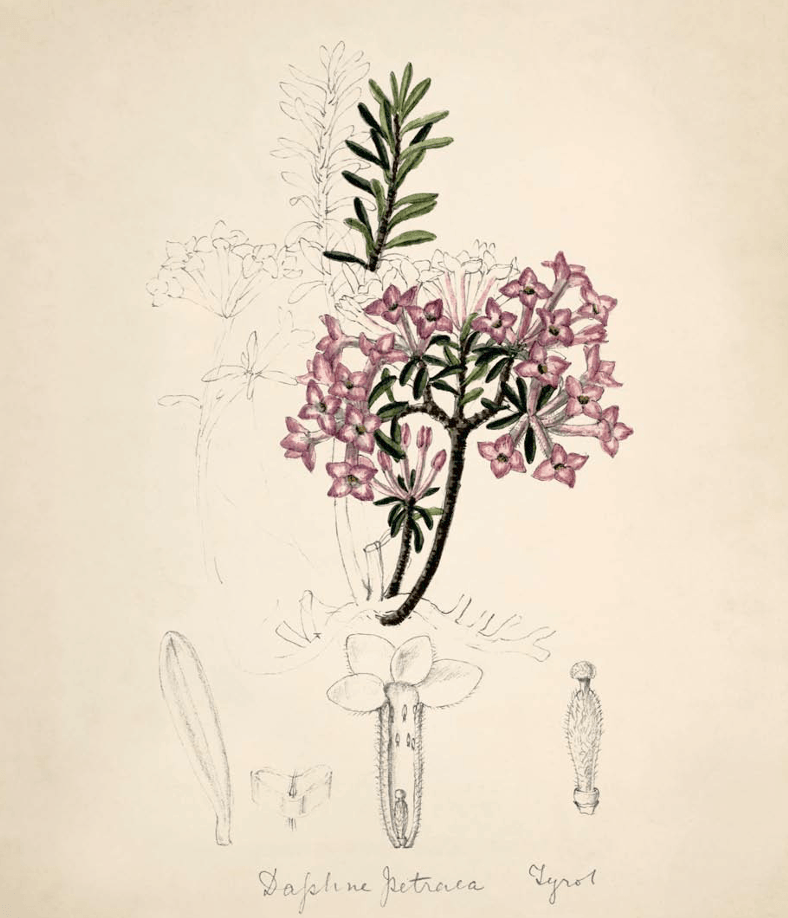Though today there are fewer botanists than in centuries past, there are more botanical artists than ever before. “These artists,” Robin Lane Fox writes in the September 25 issue of The New York Review, “are today’s close observers of flowers and fruits, now that ‘plant scientists’ have moved inward to study cells and genes. Most plant scientists are ignorant about gardening. Artists do more for susceptible gardeners’ fantasies.” Here he presents a selection of botanical drawings with commentary.
This superb Chinese peony is an old moutan variety, a class that has become more available recently to Western gardeners since the increased trade and openness of China. John Reeves was a Tea Inspector for the British East India Company in China from 1812 to 1831. While trading at Canton and Macao, he arranged for masses of unfamiliar flowers and plants to be brought to him, and for Chinese artists to paint them. As this delectable peony shows, the Chinese artists, none known to us by name, rendered flowers with a texture and rhythm that Western artists did not so readily capture. Reeve’s archive is a priceless historical and artistic resource.
Pierre-Joseph Redouté, born in 1759, is recognized as the supreme master among specialized botanical artists. He survived the French Revolution despite his close ties with Marie Antoinette and in the 1820s began to issue pictures of popular garden flowers for a wider public. These beautifully rendered auriculas demonstrate what varieties were already popular in French gardens before a competitive interest in the family took off among working class gardeners in the north of England from the 1840s onwards. Redouté’s Choix des plus belles Fleurs became his most widely known work, earning him much-needed money in his mid-sixties when, despite his appointment to the Legion d’Honneur by the restored Bourbon king Charles X, he was often on the verge of bankruptcy.
The Victorian artist Marianne North (1830–90) was an intrepid traveler to Brazil, Borneo, Jamaica, India, and many other countries for the sake of painting their flowers and plants. She is unusual among female botanical artists in using oils for her plant-portraits, many of which have a heightened sense of color and drama as result. This beautiful Brugmansia suaveolens is a sweetly-scented, half-hardy plant which is grown by gardeners nowadays in big pots and tubs on roof-gardens or beside swimming pools, and is known popularly as the Angel’s Trumpet or Datura. An entire suite of her paintings is visible in a special house in London’s Kew Gardens, the most impressive monument to her exotic travels and talent for close observation and drama.
The remarkable plant-hunter and botanical explorer, Reginald Farrer, active from 1905 to 1917, was also a gifted artist. He left many sketches of rarities that he had discovered growing wild in the mountain settings which he loved. This rare rose-pink daphne was seen and recorded by him in the rocks of the South Tyrol in Europe. His writings record hundreds of rare alpines, from the Alps to western China, and combine exact observations of each plant and petal with highly rhetorical and romantic descriptions. He writes in 1913–1914 that this daphne mostly grows only in the chinks of the grimmest grey limestone, but in June and August each one of its shoots “is ablaze with a head of three or four big waxy pink tubes of the most crystalline pure texture, the most brilliant clear colour and the most intoxicating scent.” The sight of them, flat against grey rock-faces with no green leaf showing, “amply repays the distance, difficulties, dangers and despairs that sometimes wait on its worshippers.” Very few gardeners even know of it nowadays.
This brilliant scarlet anemone, Anemone coronaria, is often seen among olives and in stony places in Greece and the Mediterranean. The Flemish artist Joris Hoefnagel shows it in this watercolor of 1591–1596 with a snail and a crane fly, or daddy longlegs. The ancient Greeks believed the flower’s blood-red color grew from the blood shed by demi-god Adonis, beloved by the goddess of love, Aphrodite, when he was killed by the virginal goddess Artemis while out hunting. Greek poets, storytellers, and mythographers often attached tales of unhappy love to the glorious flowers around them.
Advertisement
Robin Lane Fox’s article “The Gardens of Their Dreams,” a review of five books about gardening, appears in the September 25 issue of The New York Review.







